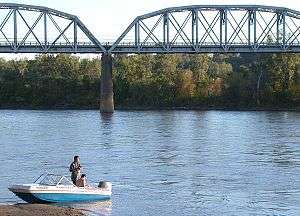Union Pacific Missouri River Bridge
Coordinates: 41°14′59″N 95°55′02″W / 41.249722°N 95.917222°W
| Union Pacific Missouri River Bridge | |
|---|---|
|
Fishermen on the Missouri River facing the Union Pacific Bridge. | |
| Carries | Railroad |
| Crosses | Missouri River |
| Locale | Council Bluffs, Iowa to Omaha, Nebraska |
| Owner | Union Pacific |
| History | |
| Opened | 1916 |
The Union Pacific Missouri River Bridge is a rail truss bridge across the Missouri River connecting Council Bluffs, Iowa with Omaha, Nebraska.
History
When the first railroad bridge on the site opened on March 25, 1873,[1] it connected the First Transcontinental Railroad to the eastern United States. The bridge was rebuilt twice, with the current bridge opening in 1916.[2]
When the Union Pacific began heading west from Omaha in 1862 there were no railroads connecting to it from the east. Initial plans called for trains to connect to it by ferry. After the Chicago and North Western Railway reached Council Bluffs in 1867, the Union Pacific for a while tried to run freight trains across the frozen river during the winter.

In 1869 the transcontinental railroad was completed. An 1871 report to stockholders has this description:
- The want of a bridge over the Missouri River, at Omaha to connect the eastern railroads with the Union Pacific, has been one of the most annoying incidents connected with the trip to California.[3]
- The bridge is of 11 spans, 250 feet each, 50 feet above high water, resting upon one store abutment now complete; and 11 iron piers, all in place and the larger part already sunk from 60 to 72 feet in the sand, and resting in the bed-rock.
This bridge quickly became obsolete as trains and locomotives increased in weight. A replacement bridge was opened in 1888. This truss bridge rested on stone masonry piers.
The 1888 bridge also became obsolete. The peak year for American railroad track mileage was 1916. Nearly all interstate commerce went by rail. Union Pacific decided to upgrade the Missouri River crossing to handle the traffic. To keep this critical artery open, the replacement bridge was constructed on temporary wooden piles immediately upstream of the 1888 stone piers. Another set of piles was driven into the river bed on the downstream side of the piers. When the new bridge was completed the old bridge was rigged with cables and winched from the stone piers to the temporary wood piles. The cables were rerigged to the new structure and it was pulled onto the stone piers. Tracks were connected and traffic resumed with less than one day of interruption. The 1888 bridge was then dismantled.

The approaches to the bridge were a mile and a half on each side. The Union Pacific initially committed to including a roadway with the bridge. However, it recanted, and it would not be until 1888 when the Douglas Street Bridge, later called the Ak-Sar-Ben Bridge, was opened as a roadway connecting the cities.
See also
References
- ↑ "Omaha's First Century - Installment V".
- ↑ Union Pacific Bridge - Nebraska Memories - ne.gov - Retrieved February 1, 2010]
- ↑ "1871 Stockholder Report" CPRR.org. Retrieved 6/19/09.
External links
- 1871 Stockholder Report (via cprr.org)
- Aerial shots of the bridge
- History of Omaha and the bridge
- Historic images of the bridge - Nebraska Memories
